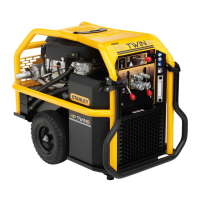16 ► HP TWIN8 User Manual
GENERAL
Tests and adjustments should be performed periodically
to ensure the power unit is operating at maximum
efciency. Use a calibrated ow and pressure tester.
This tester can be used to isolate problems in both the
engine and hydraulic system prior to any power unit
disassembly.
TESTING THE HYDRAULIC CIRCUIT
The following tests can be performed to ensure that
the hydraulic pump is supplying the correct ow and
pressure and that the system relief valve is operating
properly.
During these tests, make sure the engine is warm and
operating smoothly. If test results are not as specied,
refer to the troubleshooting table in this section for
possible causes.
TESTING THE 5 OR 8 GPM CIRCUIT
To test the circuit, proceed as follows:
1. Install a calibrated ow and pressure tester across
the two hose ends (where the tool would normally
be connected).
2. Set both ow control levers to the OFF (down)
position.
3. Set the throttle control lever to the far left for 5 GPM,
after the engine is started you can leave the lever
in this position if you are testing the 5 GPM circuit
or move the lever to the far right to test the 8 GPM
circuit.
4. Check that the tester restrictor valve is fully open
(counterclockwise) on the ow and pressure tester.
5. Start the engine and allow it to run until warm.
6. With the throttle control in the far left position, the
5-GPM circuit can be tested, or moving the lever to
the far right will allow testing the 8-GPM circuit.
a. 5-GPM Range 4-6 GPM/15-23 LPM
b. 8-GPM Range 7-9 GPM/26.5-34 LPM
7. Slowly turn the restrictor valve clockwise while
watching the pressure gauge. The ow rate shown
above in step 6 should stay at the selected ow
range.
8. When the pressure reaches 2100–2200 psi/145–
152 bar, the relief valve should begin to open. The
pressure at which the relief valve just begins to open
is commonly referred to as the “cracking pressure”.
At the “cracking pressure,” the ow rate should start
to drop because the relief valve is allowing uid to
bypass to the hydraulic reservoir. The “cracking
pressure” is preset at the factory and if it is not
within the above range (2100-2200) psi, the relief
valve must be re-set as follows: The relief valves are
located on the control block which is directly behind
the couplers on the dash panel (See item 10, page
22) for location. Use a wrench to loosen the nut
on the relief valve.
9. Use an Allen wrench to adjust the relief valve. Turn
clockwise to raise the pressure and counterclockwise
to reduce the pressure. Tighten the nut and retest.
10. Check both the 5 and 8 GPM ow settings and then
follow the same procedure to test the other circuit
(each circuit has its own relief valve).
Flow Control Lever(s)
Throttle Control Lever
CIRCUIT TESTING

